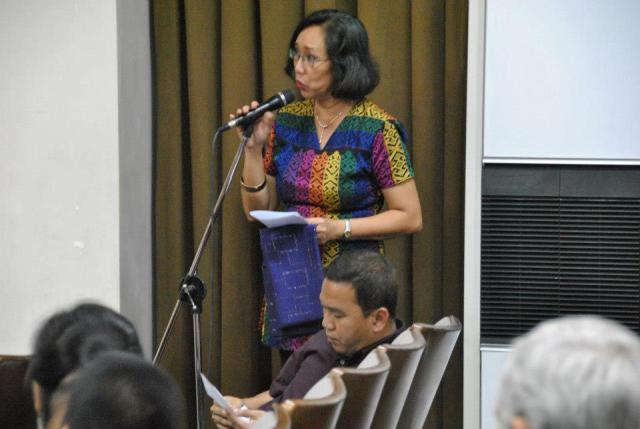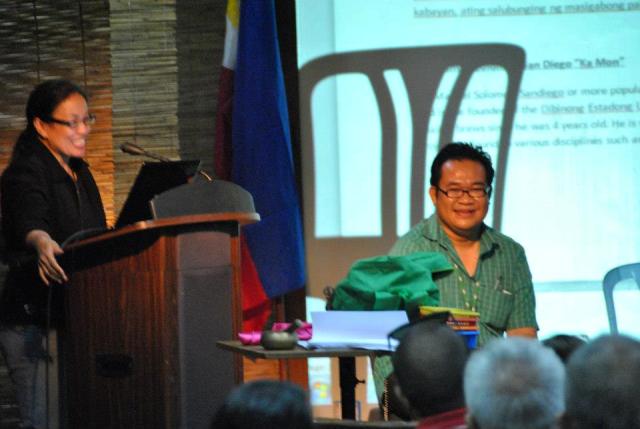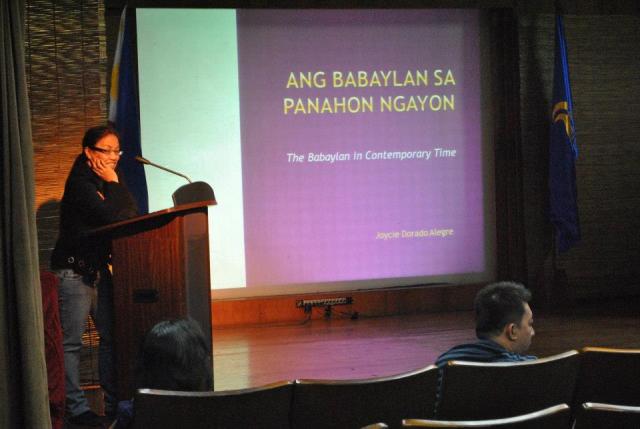Filtered By: Lifestyle
Lifestyle
Walking between heaven and earth: The babaylan today
Text and photos by Sylvia L. Mayuga
Through the open door to Lihim na Karunungan in the National Commission for Culture and the Arts’ lecture series, “Light and Mystery,” Professor Joycie Alegre walked in with its central figure, the babaylan.

Joycie Alegre, healer’s daughter and Arts & Humanities professor at UP Visayas, speaks of the path trod by the shaman, or babaylan.
“The babaylan is a medium between heaven and earth, who heals, exorcises and restores harmony to her community. Her path begins with a mysterious call,” began Alegre, who is chair of the NCCA’s Subcommission of Cultural Communities and Traditional Arts. Alegre has known of babaylan replying to that call initiated by “walking miles on their knees, getting buried alive or immersed in water overnight.” “In mental, physical, emotional and spiritual struggle, like Jesus in the desert or the Buddha’s last temptation,” they arrive at the end of their known reality. Then, “at the brink of death, the threshold between the powers of darkness and light,” comes the last stage: “a spirit appears”—and the babaylan learns about herself and her destiny in bliss. “But she must decide whether to be a sorceress, a healer or a combination of both, and return to earth to fulfill her mission,” Alegre said. If she assents, she makes a “panata—a vow, a pledge, a sacrifice or an offering,” and becomes a full-fledged babaylan. Babaylanes rife in Alegre’s native Eastern Visayas are called tambalan. Her mother is one—healing, reciting special prayers, performing rituals to ward off evil. Alegre speaks of Capul Island’s tambalan with special fascination. Tiny Capul off Northern Samar, in the path of the Spanish galleons of yore, is an anthropologist’s dream. Its name is short for Acapulco, center of the old galleon trade; its natives trace their roots to the Sama tribe of Sulu, master boatbuilders well known for their shamanism dating back to our Austronesian past. Sama roots could well be why Capul has such a rich variety of tambalan: snakebite healers, mediums for nature spirits, exorcists, paragluon healing trauma and mental illness, and mamaratbat leading “elaborate rituals” to usher departed souls “to ever-finer levels of existence for nine years until they reach heaven.” Among bits and pieces of soul strewn like gemstones in Philippine languages are words for healing in Capul’s dialect, Abaknon. Panghi-uli, “to heal,” and nahi-ulian, “healed” or “returned to the natural self,” are rooted in uli, “to return.” A towering ancestral tree looms behind the Tagalog word gumaling for “healed.” Depending on the accent, its root word, galing, can mean origin, return, gift or power. The Tagalog word gamot, or medicine, means “root” in Cebuano. A Tagalog word for God, poon, means “origin” in Ilocano. Its root, puno, could mean either “tree” or “leader.” All are clues to an ancient worldview of living oneness. Awake under our towering ancestral tree, Alegre concludes from both her life and studies of the world’s shamanic history: “The babaylan is always thought to be ancient, but she’s still here in our complex society. Anyone can be a babaylan. We have just forgotten, swallowed by the stresses of our lives.” 

Dr. Manuel S. Sandiego, both medical doctor and babaylan, has written many books of secret knowledge dictated by spirits. On his left, Trixie Cruz.
What have we forgotten? In the next lecture, Dr. Manuel Solomon “Ka Mon” Sandiego offered answers with his own life. Both a medical doctor and the founder of the spiritual sect Dibinong Estadong Unibersong Samahan, Ka Mon has concocted medical brews since age 4. In youth he healed his mother’s headaches simply by touching her: “I did it several times with consistent results. That was when I knew there was something there. It wasn’t just chance. It became automatic.” What happens when he heals? “Well, there’s a voice in my mind that tells me what to say. A flash of light and I would know, at times to the point of hiding it.” But how did he become both a modern doctor and a healer in the ancient mold? “I was researching on the mystical before I entered medicine in UST. Problem is, I became part of my own research. I would wonder how I knew the answers. Then I got a vision that said, ‘Kung mahal mo ako, iwan mo ang lahat. Sumunod ka sa akin.’” Ka Mon left medical school in his first year and hied off to a secluded barrio in Bicol, where he began to heal. Moving to destiny, he left to heal in other places after six months. “I was then allowed to go back to study medicine on condition that I return to my mission as soon as I got my license.” Having finished, he resumed his pagganap, or mission. “But I was earning nothing, so I was tempted to work for a medical consultation company. I got ill then. I coughed blood and had a heart attack, but nothing showed what it was in X-rays and tests. From then on I gave myself completely to it. I now obey everything I’m told.” In his modern shaman’s way, Ka Mon has developed a technology of the sacred, creating sigils inspired by spirit guides. What’s a “sigil”? The word comes from the Latin sigillum, seal, or the Hebrew segula—defined as “a word, action or item to command spirits. Spirit names are converted to numbers on magic squares charged with will and intent,” like the sigils Ka Mon flashed on the lecture screen. Sigils have been known to mankind since prehistory, with traces found in Greek, Roman and Renaissance history. “These are power formulas, tones, combinations of sounds and energy emanations to access other dimensions. I warn you. They are to be used only for the good,” he told his fascinated urban audience. Passing his hand over one sigil, he asked the audience how they felt. Many reported warmth in their own hands. Then he uttered an incantation to summon his spirit guide. When one reported a heavy feeling in her head, Ka Mon apologized, “I’m sorry. My frequency was too high. Let me lower it.” Healing with memory Hidden meaning in “superstitions” silently surround Filipinos from childhood, provoking many questions. “Is the babaylan always female?” one asked before Ka Mon spoke. “Not necessarily. From my experience, it doesn’t matter. There are also men and gays. What’s important is you can heal and mediate,” Alegre replied. Another asked, “How is the gay babaylan different from a woman babaylan?” The centuries opened as Alegre cited the Spanish friar Francisco Ignacio Alcina’s written records about the female babaylan a.k.a. catalonan and the male babaylan called asog. Historian Alfred McCoy discovered recorded revolts led by gay babaylan in Philippine peasant movements during and after the Spanish centuries. The most famous was Ponciano Elopre, also known as Buhawi, Bisayan for “thunderstorm.” Faithful to his name, the “gender-crossing Buhawi led one of the earliest major revolts in Negros (1887-90).” Little-known outside historical archives, the babaylan played a central role when datus accepted positions in the Spanish colonial government. Taking over the leadership of their communities, babaylanes became “the peasantry’s last recourse for their grievances...their link to the ancestral spirits...” writes gender scholar J. Neil Garcia. Tellingly, “McCoy concludes that the first peasant nationalist ideologies were propagated by babaylan with the use of syncretic Christian animist lore as they agitated to reform and/or overthrow the entire colonial social system.” There’s so much more to that hidden past, but for now let’s recall how western guile subjugated our forefathers’ worldview with superior weaponry. Like many First Peoples in the world, they blended their living reality with the armed conqueror’s religion. Having eventually resisted and survived as a sovereign nation, the memory of our pre-Conquest world still lives, if less known and valued today. Like the babaylan of old, Christian animist sects all over our islands continue to believe in sigils, anting-anting and Latinized power sounds called oracion lending otherworldly powers like invisibility and invulnerability to blades and bullets. Proof is rare and isolated, but can be found. Are they missing pieces of a giant jigsaw puzzle to heal the soul of a still-fractured nation with their own lihim na karunungan? 

NCCA legal counsel and subcommissioner for Cultural Heritage—and modern babaylan—Trixie Cruz organized the “Light and Mystery: Katutubong Karunungan” lecture series in October.
Memory is the key to wholeness. This is why Trixie Cruz, NCCA Subcommissioner for Cultural Heritage, lit the fire for "Light and Mystery." She told the audience: “When the Claveria Decree changed our names in 1856, our families did not retain our name or the memory of our ancestors’ name. This disconnected us from our ancestors. Disconnect results in trouble—personal, physical, emotional, spiritual. “Ifugaos and other Cordillera tribes still have the strength of this connection essential to our well-being. "The role of the shaman is to reestablish connections. The mumbaki, the Ifugao nation’s magicians and keepers of memory. They memorize the names of their ancestors to at least 11 generations so they can recite their adventures to present and future generations. We now study how to establish connections with the past. In 2007 the NCCA gave grants to ordain 16 mumbaki.” Starting Nov. 27, the NCCA will celebrate ancestral memory in Bulacan’s Dayo Festival. There will be ancient games, arts and 400 babaylan for panghi-uli, healing. — BM, GMA News
More Videos
Most Popular



